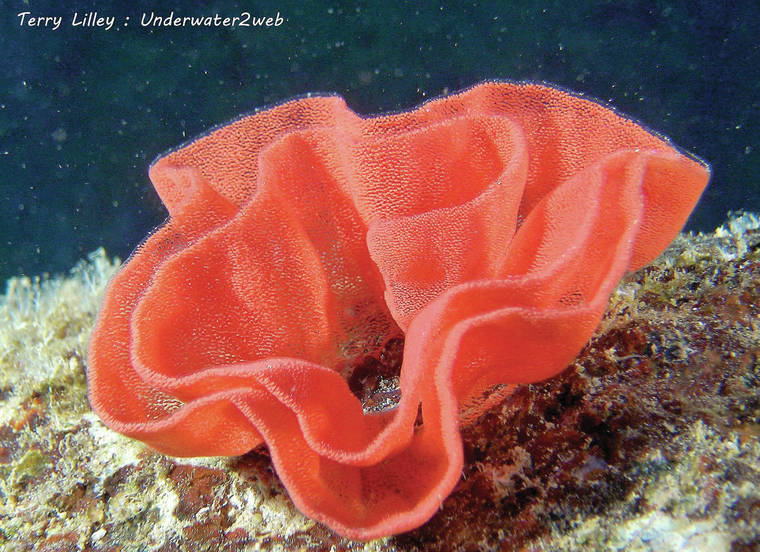While diving or snorkeling on a Hawaiian reef one may see what looks like a bright-red, four-inch-wide rose growing on the bare lava rocks. This unusual creature has petals just like a rose, and it undulates in the current, looking like a rose in your garden during a strong trade wind. As a marine biologist I often get asked by people after a snorkel, “what is that beautiful red rose doing out on the black lava reef?”
While diving or snorkeling on a Hawaiian reef one may see what looks like a bright-red, four-inch-wide rose growing on the bare lava rocks. This unusual creature has petals just like a rose, and it undulates in the current, looking like a rose in your garden during a strong trade wind. As a marine biologist I often get asked by people after a snorkel, “what is that beautiful red rose doing out on the black lava reef?”
The red reef rose is actually the eggs of a Spanish dancer nudibranch which is a very-colorful sea slug. Nudibranchs lay hundreds of thousands of tiny eegs that are all stuck together in a soft, gelatinous material in circular rows that look just like rose petals. If you look close you can see each small egg. Since the entire egg cluster is soft, it undulates in the current, looking much like a rose blowing in the wind.
It takes about three weeks for the baby nudibranchs to hatch and swim away as tiny larvae that drift in the currents until they are large enough to settle onto the reef and grow into the stunning, bright-red nudibranch. Nudibranchs get their name from the words “nude gills” because their gills are feathery-looking structures that protrude outwards from the top of the sea slugs body versus having gills within their heads, like most fish species.
When you are diving and you look into a dark cave with your bright dive lights and see these bright-red, rose-like eggs sacks attached to the reef, it is quite a stunning sight. It seems like every predator from the octopus, sea stars and sea urchins would eat the nutritious eggs, but they are almost always left alone. We know that the nudibranchs have a toxin in their skin that keeps them from being eaten, and the egg sacs more than likely contain the same toxins.
Different species of nudibranchs lay different-colored egg clusters. Some are pure white, bright yellow or pink. You can tell by the color of the eggs which species of nudibranch laid them. Diving in California where there are more nudibranch species then there are here in Hawai‘i, I have seen several different-colored nudibranch egg clusters on a single rick, and it really does look like an underwater rose garden.
You can see the beautiful Spanish dancer nudibranch and their colorful eggs on the underwater educational web page, underwater2web.com in the movie “The World’s Guide To Hawaiian Reef Creatures,” and also follow the marine-life Instagram post at terry.lilley.
•••
Terry Lilley, a marine biologist, lives in Hanalei. His websites include underwater-2web.com and www.gofundme.com/5urrm4zw.




“than” there are here, not “then”